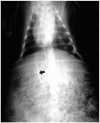The induction of hyperthermia in rabbit liver by means of duplex stainless steel thermoseeds
- PMID: 12087199
- PMCID: PMC2713842
- DOI: 10.3348/kjr.2002.3.2.98
The induction of hyperthermia in rabbit liver by means of duplex stainless steel thermoseeds
Abstract
Objective: To determine the heating characteristics of needle-shaped duplex stainless steel thermoseeds, and to evaluate their effectiveness in the induction of hyperthermia in rabbit liver.
Materials and methods: Thermoseeds of the two different shapes, L-shaped for single doses of hyperthermia and I-shaped for in-vitro study and repeated hyperthermic induction, were prepared. For the in-vitro study, an I-shaped thermoseed 0.23 mm in diameter and 25 mm long was placed inside a plastic tube filled with water. Heat was applied for 30 minutes within an induction magnetic field, and during this time changes in temperature were recorded using three thermocouples. For the in-vivo study, fifteen New Zealand white rabbits were divided into five equal groups. An I-shaped or L-shaped thermoseed was inserted in each rabbit's liver, and then placed within the center of the magnetic induction coil during a 30-minute period of hyperthermia. The rabbits in the first group were sacrificed immediately after hyperthermia was induced once, while those in the other groups were sacrificed at 1, 3, and 7 days, respectively, also after one induction. The remaining three rabbits were sacrificed 4 days after three consecutive daily treatment sessions. The resected segments of liver were subsequently evaluated histopathologically for the extent of coagulation necrosis caused by heating of the thermoseed.
Results: The in-vitro study demonstrated that the temperature in the thermoseed, which was 25.9 degrees C before heating and 54.8 degrees C after heating, rose rapidly at first but progressively less rapidly as time elapsed. Light microscopic examination of the rabbits' livers revealed coagulation necrosis and infiltration by inflammatory cells around the insertion site of the thermoseed. The maximum diameter of coagulation necrosis was 2.81+/-1.68 mm, and this occurred in the rabbits that were sacrificed 7 days after heat induction.
Conclusion: Needle-shaped duplex stainless steel thermoseeds show temperature-dependent-type heating characteristics, and in rabbit liver, induced coagulation necrosis of surrounding tissues after heat is applied for 30 minutes. These thermoseeds may thus be useful for the induction of interstitial hyperthermia.
Figures





Similar articles
-
Feasibility study of high-temperature thermoseed inductive hyperthermia in melanoma treatment.Oncol Rep. 2011 Apr;25(4):953-62. doi: 10.3892/or.2011.1143. Epub 2011 Jan 13. Oncol Rep. 2011. PMID: 21234522
-
Effect of implant variables on temperatures achieved during ferromagnetic hyperthermia.Int J Hyperthermia. 1992 Mar-Apr;8(2):241-51. doi: 10.3109/02656739209021779. Int J Hyperthermia. 1992. PMID: 1573313
-
Ferromagnetic hyperthermia in rabbit eyes using a new glass-ceramic thermoseed.Graefes Arch Clin Exp Ophthalmol. 1994 Mar;232(3):176-81. doi: 10.1007/BF00176788. Graefes Arch Clin Exp Ophthalmol. 1994. PMID: 8188068
-
Practical aspects of ferromagnetic thermoseed hyperthermia.Radiol Clin North Am. 1989 May;27(3):589-602. Radiol Clin North Am. 1989. PMID: 2648461 Review.
-
Advances in magnetic induction hyperthermia.Front Bioeng Biotechnol. 2024 Aug 5;12:1432189. doi: 10.3389/fbioe.2024.1432189. eCollection 2024. Front Bioeng Biotechnol. 2024. PMID: 39161353 Free PMC article. Review.
Cited by
-
Calculation of heating power generated from ferromagnetic thermal seed (PdCo-PdNi-CuNi) alloys used as interstitial hyperthermia implants.J Mater Sci Mater Med. 2007 Mar;18(3):523-8. doi: 10.1007/s10856-007-2013-1. J Mater Sci Mater Med. 2007. PMID: 17334704
-
Design and construction of a Maxwell-type induction coil for magnetic nanoparticle hyperthermia.Int J Hyperthermia. 2020;37(1):1-14. doi: 10.1080/02656736.2019.1704448. Int J Hyperthermia. 2020. PMID: 31918595 Free PMC article.
-
Magnetic and hydrogel composite materials for hyperthermia applications.J Mater Sci Mater Med. 2004 Oct;15(10):1061-4. doi: 10.1023/B:JMSM.0000046386.78633.e5. J Mater Sci Mater Med. 2004. PMID: 15516865
-
Tailor made magnetic nanolights: fabrication to cancer theranostics applications.Nanoscale Adv. 2021 Oct 25;3(24):6762-6796. doi: 10.1039/d1na00447f. eCollection 2021 Dec 7. Nanoscale Adv. 2021. PMID: 36132370 Free PMC article. Review.
-
On the Biomechanical Performances of Duplex Stainless Steel Graded Scaffolds Produced by Laser Powder Bed Fusion for Tissue Engineering Applications.J Funct Biomater. 2023 Sep 22;14(10):489. doi: 10.3390/jfb14100489. J Funct Biomater. 2023. PMID: 37888154 Free PMC article.
References
-
- Goldberg SN, Gazelle GS, Mueller PR. Thermal ablation therapy for focal malignancy: a unified approach to underlying principles, techniques, and diagnostic imaging guidance. AJR. 2000;174:323–331. - PubMed
-
- Brezovich IA, Ruby FM. Practical aspect of ferromagnetic thermoseed hyperthermia. Radiol Clin North Am. 1989;27:589–602. - PubMed
-
- Stauffer PR, Cetas TC, Jones RC. Magnetic induction heating of ferromagnetic implant for inducing localized hyperthermia in deep-seated tumors. IEEE Trans Biomed Eng. 1984;31:76–90. - PubMed
-
- Brezovich IA, Atkinson WJ. Temperature distribution in tumor model heated by self-regulating nickel-copper alloy thermoseed. Med Phys. 1984;11:145–152. - PubMed
Publication types
MeSH terms
Substances
LinkOut - more resources
Full Text Sources

